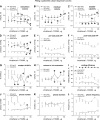Sprouting of substance P-expressing primary afferent central terminals and spinal micturition reflex NK1 receptor dependence after spinal cord injury
- PMID: 18945947
- PMCID: PMC2685299
- DOI: 10.1152/ajpregu.90653.2008
Sprouting of substance P-expressing primary afferent central terminals and spinal micturition reflex NK1 receptor dependence after spinal cord injury
Abstract
The primary afferent neurotransmitter triggering the spinal micturition reflex after complete spinal cord injury (SCI) in the rat is unknown. Substance P detected immunohistochemically in the sacral parasympathetic nucleus was significantly higher in 12 SCI rats than in 12 spinally intact rats (P = 0.008), suggesting substance P as a plausible candidate for the primary afferent neurotransmitter. The effects of the tachykinin NK1 receptor antagonist L-733060 on the spinal micturition reflex were then determined by performing conscious cystometry in an additional 14 intact rats and 14 SCI rats with L-733060 (0.1-100 microg) administered intrathecally at L6-S1. L-733060 was without effect in intact rats, but blocked the spinal micturition reflex in 10 of 14 SCI rats and increased the intermicturition interval in 2 of 4 others at doses ranging from 10 to 100 microg. Both phasic and nonphasic voiding contractions, differentiated according to the presence of phasic external urethral sphincter (EUS) activity, were present in most SCI rats. Both types of contractions were blocked by high doses of L-733060. Interestingly, there was a relative decline in phasic voiding contractions at high doses as well as a decline in contraction amplitude in nonphasic voiding contractions. In other respects, cystometric variables were largely unaffected in either spinally intact or SCI rats. L-733060 did not affect tonic EUS activity at any dose except when the spinal micturition reflex was blocked and tonic activity was consequently lost. These experiments show that tachykinin action at spinal NK1 receptors plays a major role in the spinal micturition reflex in SCI rats.
Figures










Similar articles
-
Serotonergic drugs and spinal cord transections indicate that different spinal circuits are involved in external urethral sphincter activity in rats.Am J Physiol Renal Physiol. 2007 Mar;292(3):F1044-53. doi: 10.1152/ajprenal.00175.2006. Epub 2006 Oct 17. Am J Physiol Renal Physiol. 2007. PMID: 17047164 Free PMC article.
-
The role of capsaicin-sensitive afferent fibers in the lower urinary tract dysfunction induced by chronic spinal cord injury in rats.Exp Neurol. 2004 Jun;187(2):445-54. doi: 10.1016/j.expneurol.2004.02.014. Exp Neurol. 2004. PMID: 15144870
-
Intrathecal glutamate promotes glycinergic neuronal activity and inhibits the micturition reflex in urethane-anesthetized rats.Int J Urol. 2006 Dec;13(12):1519-24. doi: 10.1111/j.1442-2042.2006.01651.x. Int J Urol. 2006. PMID: 17118028
-
Neurochemical plasticity and the role of neurotrophic factors in bladder reflex pathways after spinal cord injury.Prog Brain Res. 2006;152:97-115. doi: 10.1016/S0079-6123(05)52007-7. Prog Brain Res. 2006. PMID: 16198696 Review.
-
Nociceptin and the micturition reflex.Peptides. 2000 Jul;21(7):1007-21. doi: 10.1016/s0196-9781(00)00241-2. Peptides. 2000. PMID: 10998535 Review.
Cited by
-
Lipopolysaccharides induce a RAGE-mediated sensitization of sensory neurons and fluid hypersecretion in the upper airways.Sci Rep. 2021 Apr 16;11(1):8336. doi: 10.1038/s41598-021-86069-6. Sci Rep. 2021. PMID: 33863932 Free PMC article.
-
Plasticity of non-adrenergic non-cholinergic bladder contractions in rats after chronic spinal cord injury.Brain Res Bull. 2011 Aug 10;86(1-2):91-6. doi: 10.1016/j.brainresbull.2011.06.001. Epub 2011 Jun 13. Brain Res Bull. 2011. PMID: 21689735 Free PMC article.
-
Neural mechanisms underlying lower urinary tract dysfunction.Korean J Urol. 2014 Feb;55(2):81-90. doi: 10.4111/kju.2014.55.2.81. Epub 2014 Feb 14. Korean J Urol. 2014. PMID: 24578802 Free PMC article. Review.
-
Current Knowledge and Novel Frontiers in Lower Urinary Tract Dysfunction after Spinal Cord Injury: Basic Research Perspectives.Urol Sci. 2022 Jul-Sep;33(3):101-113. doi: 10.4103/uros.uros_31_22. Epub 2022 Aug 25. Urol Sci. 2022. PMID: 36177249 Free PMC article.
-
Morphological changes in different populations of bladder afferent neurons detected by herpes simplex virus (HSV) vectors with cell-type-specific promoters in mice with spinal cord injury.Neuroscience. 2017 Nov 19;364:190-201. doi: 10.1016/j.neuroscience.2017.09.024. Epub 2017 Sep 20. Neuroscience. 2017. PMID: 28942324 Free PMC article.
References
-
- Barber RP, Phelps PE, Houser CR, Crawford GD, Salvaterra PM, Vaughn JE. The morphology and distribution of neurons containing choline acetyltransferase in the adult rat spinal cord: an immunocytochemical study. J Comp Neurol 229: 329–346, 1984. - PubMed
-
- Battaglia G, Rustioni A. Coexistence of glutamate and substance P in dorsal root ganglion neurons of the rat and monkey. J Comp Neurol 277: 302–312, 1988. - PubMed
-
- Cheng CL, de Groat WC. The role of capsaicin-sensitive afferent fibers in the lower urinary tract dysfunction induced by chronic spinal cord injury in rats. Exp Neurol 187: 445–454, 2004. - PubMed
-
- Cheng CL, Liu JC, Chang SY, Ma CP, de Groat WC. Effect of capsaicin on the micturition reflex in normal and chronic spinal cord-injured cats. Am J Physiol Regul Integr Comp Physiol 277: R786–R794, 1999. - PubMed
Publication types
MeSH terms
Substances
Grants and funding
LinkOut - more resources
Full Text Sources
Medical
Molecular Biology Databases

